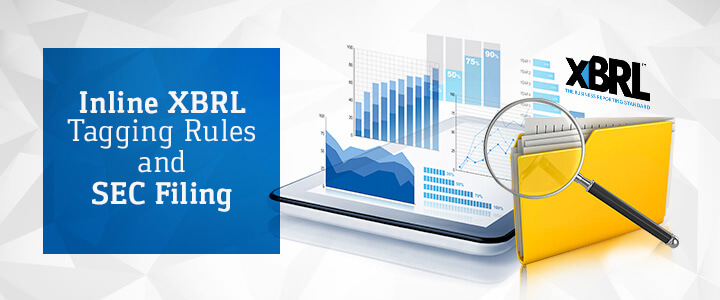Inline XBRL Tagging Rules and SEC Filing
The US Securities and Exchange Commission or SEC, made an announcement with regard to the filing of financial statements in the Inline XBRL format, in June 2016. This filing system is optional in nature till 2020, after which it might become the compulsory format. Companies prefer to adopt this new format as it has been proved to be more time and cost effective.
Before indulging in easy ways to master this modified form of SEC Filing, it would be pertinent to mention some key terms, for better understanding.
Extensive Business Reporting Language is a popular form whereby financial information is successfully disseminated. The receivers and users of this financial information prefer to receive it this way as this digital format makes a quick analysis using analytic readers. All information received is given in a global format, which is understood by all and leaves very little scope for misinterpretation. However, to ensure this, every piece of information is tagged with an accounting label, which is in the form of a standardized taxonomy. The taxonomy is based on Generally Accepted Accounting Principles, United States (US GAAP), which has been adopted by the SEC or the International Financial Reporting Standards (IFRS), which has been developed by International Accounting Standards Board (IASB). This financial information is also easily importable into various financial models for further processing.

This tagging system gives all financial information relevant tags, according to the most relevant element in an accounting taxonomy. This greatly helps in the identification and classification of all the financial data that has been collected and makes it easy to import this data to its relevant financial model for further processing.
The inline xbrl format is an improved form of XBRL as it includes all the benefits provided by the original format, but facilitates easy reading and a better layout at the same time.
The following rules will help you grab a better understanding of your Inline XBRL for SEC filings
Align value formats
As, in an HTML report, each entity’s style of reporting is different; there are various ways to report the same element and XBRL conversion companies master this. To avoid variations, the XBRL taxonomy elements (area specific hierarchical dictionaries) provide the patterns that are required for every reporting element. This, in turn, ensures consistency in reporting by all the entities in HTML report of a SEC filing.
Reversing value signage
Wrong signs for values are a pretty common mistake that is often seen in an Extensive Business Reporting Language Rule 6.6.30 of the Edgard Filing Manual says that the symbol of a numeric fact has to be inverted only in a case where the balance type of element is inconsistent with the reported concept. As an attempt is also made to make the information easily readable, this rule is misused. iXBRL is an improvement over XBRL as it aims at an improved presentation of the data, and because of this, the mistakes that occur as a result of wrong signage should be reduced by a significant number. The files should also make sure that the correct signs are assigned to such values which are important to XBRL filing requirements.
Tagging invisible data
There are times when the data that requires tagging is not apparent on the face of the document, but it needs to be tagged since it is important information that can’t be lost. In such a case, the data needs to be tagged in the XBRL format so that it can be processed by the machines. It may also be a requirement under the SEC rules that all relevant data has to be tagged, even if it is mentioned only once in the document, especially where such values are relevant for both current and previous sessions (for the purpose of comparison). There is also some information which is not explicitly mentioned in the HTML document but has to be interpreted on the basis of the text. In such situations, iXBRL needs to be implemented in such a way that it is in accordance with the structured date format. Such information needs to be classified as “hidden tags” in the iXBRL formatted document and can be extracted when the need arises. Also, you can read top 5 rules about xbrl tagging.
Include all important information
Filers need to tag all the important information carefully, so as not to miss any relevant piece of information. All the financial data needs to be tagged with caution. If an important piece of data is left untagged, it cannot be retrieved or extracted as a part of the XBRL data. However, it will be present in the HTML report.
Tagging duplicate facts
Prone to error as we are, in any financial data, the same information can often be found highlighted in a number of places. This causes a problem during xbrl data validation. As the iXBRL format is document-driven, such repetitions can’t be avoided. However, in such cases, the XBRL software comes in handy. This software handles the facts that have been mentioned in multiples places while it transforms iXBRL to XBRL for the purpose of validating the financial data. Directions have been provided on managing this multiplicity of facts in the XBRL format, under the XBRL International guidelines.
The change in the XBRL format is only in relation to the format of the file which will now be accepted. Another reason that justified the importance of xbrl is that it makes the financial data human and machine-readable. There is no change in the information that needs to be tagged. The new format is not to be compulsorily adopted before 2020. However, it is being welcomed as it aims at better efficiency and data quality. iXBRL eliminates the need to create and manage individual documents and administer control over complex data. One of the advantages of XBRL for financial reporting is that financial information in this format can be seen in any browser where the visible data can be seen “as is”. In case one wants to see the tags and the XBRL properties, specialized software is needed.
iXBRL is used all over the globe. In the UK, more than two million companies have adopted this format. More than 9000 listed companies and investment funds utilize it to submit their financial data to the Japan Financial Services Agency or JFSA.
The best thing to do always is to opt for XBRL outsourcing as expert assistance keep you safeguarded from any probable complications. If you too feel a need for best quality XBRL tagging services and XBRL conversion services, our expertise can definitely help you. Reach us and let’s discuss in detail.



